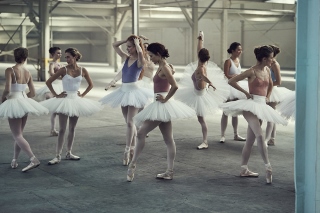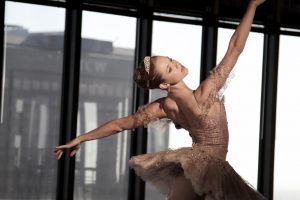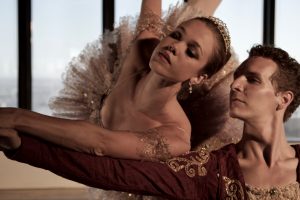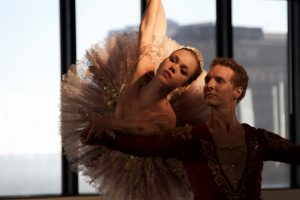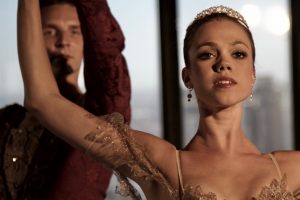BALLET’S HIDDEN BEGINNINGS
“There is only now.”
American Contemporary Ballet (ACB)’s Artistic Director, Lincoln Jones, quoted famed choreographer George Balanchine at the premiere of the company’s latest performance high above the Los Angeles skyline on the 32nd floor of downtown’s BLOC building. The quote described the fleeting nature of dance, which has always been difficult to capture in its original form because of the historical tendency for dancers and choreographers to alter the steps to their taste. To remedy this, ACB created a program–which sadly played for one weekend only–that focused on some of the most well-known ballets composed by Tchaikovsky. This beautiful, inspiring event offered, for one, forgotten scenes that helped build character and add depth; scenes which, despite not being well-appreciated by audiences at the time of their release, helped influence the creation of what we now consider to be classic works of ballet.
Part of the 1-hour program, Tchaikovsky in Ballet, included pieces that had been either changed from The Sleeping Beauty and Swan Lake, or, in the case of The Nutcracker, redone by George Balanchine, whose version was performed after that of the original choreographer, Lev Ivanov. Each sequence was set to live music by a small string and wind orchestra led by pianist and music coordinator Alin Melik-Adamyan. The chamber ensemble was situated directly behind the few rows of seats gathered at one end of the warehouse-like space, creating an appropriately intimate setting for what felt like the revelation of an old secret as the routines unfolded in patterns that hadn’t been seen in over a century.
Dance historian Doug Fullington staged these numbers based on information found in old manuscripts detailing the ways in which the ballets were performed when they first premiered to audiences in the late nineteenth century.
From Sleeping Beauty (1892), choreographed by Marius Petipa, came “Prologue Variations for Six Fairies”–part of the early versions of the ballet, but eventually altered. It formed part of “The Christening” in which the fairy godmothers bless the princess Aurora with special gifts shortly after she is born. Each of the dances, marked by drastic shifts in music, was descriptive of their presents: Candide, played by Emily Smith, began her brief routine to soft piano-playing. Her expression was demure and her steps, simple yet elegant, consisted in part of gentle crisscross patterns that brought her closer to, then farther away from the audience. Her gift was purity and bore a distinct difference from Theresa Farrell’s follow-up string routine full of eager gallops and wide smiles. Farrell was Coulante, Fleur de farine and provided Aurora with the gift of dance.
The movements were also heavily based in pantomime. Anabel Alpert, who played Canari and presented the princess with the gift of song, fluttered her hands behind her back in imitation of bird wings and shook her palms and fingers quickly on either side of her body to match the vibrations of music and singing.
Later in the evening was Swan Lake (choreographed by Ivanov in 1895), which enhanced this concept by presenting an entire segment of pantomime as the “First Lakeside Scene.” The act is a meeting that occurs between Odette, the Swan Princess (Smith), and Prince Siegfried (David Morse) when he discovers she has been cursed by the wizard whom he then vows to kill; a short scroll in the program translated the mimed conversation. Smith and Morse’s silent movements relied heavily on the upper body and face for clarity. The dancers not only nodded and pointed to one another and their surroundings to make themselves understood, but also raised their arms in a flexed triumphant pose when indicating protection and salvation, an indication of the Prince’s intentions for Odette. (In a short Q&A that took place after the show, Jones explained that pantomimes had not only became old fashioned, but also grew to be out of place in ballet over the years. This influence came in part from Balanchine, who did not take on a full production of Swan Lake, but was greatly responsible for the developmental changes that took place in ballet about a half a century later, as he opted for less emphasis on story and characters in his work.)
Sandwiched between Sleeping Beauty and Swan Lake were scenes from The Nutcracker that presented a comparative piece between the early choreographer (Ivanov) and Balanchine. Jones’s noted in his brief pre-curtain speech that the ballet flopped when it premiered in 1892. Balanchine’s newer, more technical approach to dance and his desire to create his own brand and style became the main reason behind his reworking of the show, which he helped popularize after his version premiered in 1954. To demonstrate the differences, we had two dances from the ballet: “Adagio” from the “Grand pas de deux,” a duet between the Prince and the Sugar Plum Fairy, and the Sugar Plum Fairy’s solo dance. Shelby Whallon and Morse played the roles of the Prince and Fairy in Ivanov’s interpretation. Their movements represented a sense of blissful content, a simple routine that placed Whallon as the center of the scene with her delicate, music box–like turns. Their extensions were generally softer and more curved, giving the number a warmer feel.
Although Balanchine’s choreography was more technical and complicated, Ivanov’s influence on him was still subtlety visible in the moments in which the pair coupled to dance and spin together. Rather than completely rewriting the scene, he opted for longer extensions and more dramatic movements that made Tchaikovsky’s soundtrack pop. The romance was played up by Cara Hansvick and Mate Szentes as the new duo who constantly reach out for each other and hold hands to pull one another closer. Their lifts are difficult and sudden; although Hansvick fell during one quick encounter with her partner, her recovery was instant and did not affect the rest of her performance as the two kept in time with the tempo of the music and loud violins. Even Tiger Curran’s costumes, mauve and embroidered as a nod to Balanchine’s original design, were a sharp contrast to Ivanov’s version’s subtle cream and gold.
ACB concluded its historical examination of the significance of conserving choreography with Tchaikovsky Suite No. 3 (1970) and Mozartiana (1981), two Balanchine originals that could not have existed if it weren’t for Ivanov and Petipa. Neither ballet explicitly explains who the characters are, making them true to Balanchine form. Their purpose and personalities are gathered through the performances, and although they are not as directly conversational with their movements, they do still convey strong character traits through their expressions. Especially in Mozartiana’s case, with a significant movement that looks mimed’”the main character (Whallon) pressed her hands together in prayer during the appropriately-named scene “Preghiera” and extended them high above her head more than once while looking up at the sky.
In particular, the deep emotions with which “Elégié” from Tchaikovsky Suite No. 3 were brought to life made the act gloriously enjoyable to watch, both because of the performances and the new lens with which the subtleties in the movements became more apparent. Hansvick and Szentes’ chemistry was strong. Szentes’ portrayal of loss and joy at finding and being forced to give up his partnership with Hansvick’s character was palpable, also in part thanks to their close proximity to the audience. Their depiction of falling head over heels in love by touching their foreheads together as they made eye contact and spun was poignant and tender. As was Hansvick and her small entourage’s way of blocking Szentes from moving closer to her by raising their open palms in a familiar “stop”-ping gesture.
The night felt like a one-of-a-kind experience by way of ACB’s educational approach to the show, which was great for analyzing the movements and in the ballet scenes that had gone so long without being witnessed they had virtually become new. This incredible program should be repeated so future choreographers can get the chance to discover something from the old work that may also inspire them to create their own masterpieces.
photos by Art Lessman
part of the MUSIC+DANCE:LA series
700 S. Flower St., 32nd Floor
ends on June 18, 2017
for tickets, visit ACB Dances
